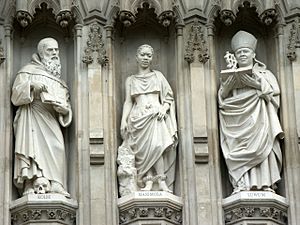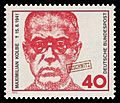Maximilian Kolbe facts for kids
Quick facts for kids SaintMaximilian Kolbe OFM Conv. |
|
|---|---|

Kolbe in 1936
|
|
| Martyr | |
| Born | Raymund Kolbe 8 January 1894 Zduńska Wola, Congress Poland, Russian Empire |
| Died | 14 August 1941 (aged 47) Auschwitz-Birkenau, German-occupied Poland |
| Venerated in | |
| Beatified | 17 October 1971, Vatican City by Pope Paul VI |
| Canonized | 10 October 1982, Vatican City by Pope John Paul II |
| Major shrine | Basilica of the Omni-mediatress of All Glories |
| Feast | 14 August |
| Attributes | |
Maximilian Maria Kolbe (born Raymund Kolbe; 1894–1941) was a brave Polish Catholic priest. He was a Franciscan friar who made the ultimate sacrifice. During World War II, he volunteered to die in place of another man. This happened in the German death camp of Auschwitz in German-occupied Poland.
Kolbe was very active in his faith. He promoted devotion to the Virgin Mary. He founded and managed the Niepokalanów monastery near Warsaw. He also ran an amateur-radio station (SP3RN) and started several publications.
On October 10, 1982, Pope John Paul II declared Kolbe a saint. He is known as a martyr of charity because of his selfless act. The Catholic Church honors him as the patron saint of amateur radio operators, political prisoners, families, journalists, and prisoners. Pope John Paul II called him "the patron of our difficult century." His feast day is August 14, the day he died. Kolbe is also known as the Apostle of Consecration to Mary for his efforts to encourage devotion to Mary.
Early Life and a Special Vision
Raymund Kolbe was born on January 8, 1894, in Zduńska Wola, a town in what was then the Russian Empire. He was the second son of Julius Kolbe, a weaver, and Maria Dąbrowska, a midwife. His father was of German background, and his mother was Polish. He had four brothers. Soon after he was born, his family moved to Pabianice.
When Kolbe was 12 years old in 1906, he had a very important experience. He saw a vision of the Virgin Mary. He later explained what happened: That night, he asked the Mother of God what his future would be. She appeared holding two crowns, one white and one red. She asked if he would accept either. The white crown meant he would stay pure, and the red crown meant he would become a martyr. Kolbe said he would accept both.
Becoming a Franciscan Friar
In 1907, Kolbe and his older brother Francis joined the Conventual Franciscans. They enrolled in a Franciscan seminary in Lviv that same year. In 1910, Kolbe was allowed to become a novice, which is a period of training. He chose the religious name Maximilian. He made his first vows in 1911 and his final vows in 1914. At this time, he added the name Maria (Mary) to his religious name.
Studies in Rome and World War I
In 1912, Kolbe was sent to Rome to study at the Pontifical Gregorian University. He earned a doctorate in philosophy in 1915. He continued his studies at the Pontifical University of St. Bonaventure, where he earned a doctorate in theology. He was very dedicated to the idea of consecration and entrustment to Mary.
While he was a student, Kolbe saw protests against the Popes in Rome. These protests were by a group called the Freemasons. Kolbe described seeing their flag with an image of Lucifer defeating the archangel Michael. Many pamphlets were also given out that criticized the Pope.
Because of this, on October 16, 1917, Kolbe started a group called the Militia Immaculatae (Army of the Immaculate One). Its goal was to help convert sinners and those who were against the Catholic Church, especially the Freemasons, through the help of the Virgin Mary. Kolbe was so serious about this that he added a special prayer to the traditional Miraculous Medal prayer. He wanted the entire Franciscan Order to be dedicated to the Immaculate Conception.
Becoming a Priest and Missionary Work
In 1918, Kolbe became a priest. In July 1919, he returned to Poland, which had just become independent. He continued to promote devotion to the Virgin Mary. He was also strongly against leftist and communist movements.
From 1919 to 1922, he taught at the Kraków Seminary. During this time, he suffered from tuberculosis, a serious lung disease. This forced him to take a long break from teaching. In those days, before antibiotics, tuberculosis was often deadly.
In January 1922, Kolbe started a monthly magazine called Rycerz Niepokalanej (Knight of the Immaculata). From 1922 to 1926, he ran a religious publishing house in Grodno. As his work grew, he founded a new Franciscan monastery in 1927 at Niepokalanów near Warsaw. This monastery became a very important center for religious publishing. A junior seminary, a school for future priests, opened there two years later.
Missions in Asia
Between 1930 and 1936, Kolbe went on several missions to East Asia. He first went to Shanghai, China, but did not gain many followers there. Then he moved to Japan. By 1931, he had founded a Franciscan monastery called Mugenzai no Sono near Nagasaki.
Kolbe also started publishing a Japanese version of the Knight of the Immaculata. The monastery he founded is still important in the Catholic Church in Japan today. Kolbe built the monastery on a mountainside. Later, when the United States dropped the atomic bomb on Nagasaki, Kolbe's Franciscan monastery survived. The Immaculate Conception Cathedral, which was on the other side of the mountain, was destroyed.
In mid-1932, Kolbe left Japan for Malabar, India. There, he founded another monastery, which has since closed.
Returning to Poland
While Kolbe was away, the monastery at Niepokalanów began publishing a daily newspaper called Mały Dziennik (the Small Diary). This newspaper became very popular, reaching a circulation of 137,000 copies, and even more on weekends. Kolbe returned to Poland in 1933 for a meeting of his religious order in Kraków. He then went back to Japan and stayed there until 1936. He was called back to Poland and was appointed the head of Niepokalanów, which meant he could not return to Japan. Two years later, in 1938, he started a radio station at Niepokalanów called Radio Niepokalanów. He had an amateur radio license with the call sign SP3RN.
World War II and Arrest
When World War II began, Kolbe was one of the few friars who stayed at the monastery. He helped organize a temporary hospital there. The Germans captured the town and arrested him on September 19, 1939. He was released on December 8. Kolbe refused to sign a document that would have given him rights similar to German citizens in exchange for recognizing his German ancestry.
After his release, he continued his work at the friary. He and other friars provided shelter to refugees, including about 2,000 Jewish people, whom he hid from German persecution. Kolbe was allowed to continue publishing religious works, though on a smaller scale. The monastery also published some materials that were against the Nazi Germans.
Life in Auschwitz
On February 17, 1941, the German authorities closed the monastery. That day, Kolbe and four other people were arrested by the Gestapo, the German secret police. They were imprisoned in the Pawiak prison. On May 28, he was moved to Auschwitz concentration camp and became prisoner number 16670.
Even in the camp, Kolbe continued to act as a priest. He faced harsh treatment, including beatings. At one point, friendly inmates secretly helped him get to the prison hospital.
A Heroic Sacrifice
In late July 1941, a prisoner escaped from Auschwitz. To punish the other prisoners and stop future escapes, the deputy camp commander, Karl Fritzsch, chose ten men to be starved to death in an underground bunker. When one of the chosen men, Franciszek Gajowniczek, cried out, "My wife! My children!" Kolbe stepped forward. He volunteered to take Gajowniczek's place.
An eyewitness said that in his prison cell, Kolbe led the prisoners in prayer. Each time the guards checked on him, he was either standing or kneeling calmly. After two weeks of being starved and without water, only Kolbe and three others were still alive.
The guards wanted the bunker empty, so they gave the remaining four prisoners deadly injections of carbolic acid. It is said that Kolbe calmly raised his left arm and waited for the injection. He died on August 14, 1941. His body was cremated the next day, August 15, which is the feast day of the Assumption of Mary.
Becoming a Saint
On May 12, 1955, the Holy See (the Pope's authority) recognized Kolbe as a Servant of God. Pope Paul VI declared him venerable on January 30, 1969. He was then beatified as a Confessor of the Faith by Pope Paul VI in 1971. Finally, he was canonized as a saint by Pope John Paul II on October 10, 1982.
After he became a saint, a special feast day for Maximilian Kolbe was added to the General Roman Calendar. He is one of ten 20th-century martyrs whose statues are placed above the Great West Door of Anglican Westminster Abbey in London. The Church of England also remembers Maximilian Kolbe with a commemoration on August 14.
His Lasting Influence
[[File:Kościół MB Ostrobramskiej w Chrzanowie 13 (cropped).jpg|thumb|The first monument to Maximilian Kolbe in Poland in Chrzanów] You can find images of Saint Maximilian Kolbe in churches all over the world. Several churches in Poland are named after him. A museum, the Museum of St. Maximilian Kolbe "There was a Man", opened in Niepokalanów in 1998.
In 1963, Rolf Hochhuth wrote a play called The Deputy, which was greatly inspired by Kolbe's life. In 2000, a place called Marytown in Libertyville, Illinois, was named the National Shrine of St. Maximilian Kolbe. It includes an exhibit about the Holocaust and Kolbe's story. In 1991, Krzysztof Zanussi released a Polish film about Kolbe's life called Life for Life: Maximilian Kolbe. The Polish Senate declared 2011 the year of Maximilian Kolbe. Many Catholic institutions around the world have chosen Kolbe as their patron saint.
Images for kids
-
Stained-glass window by Alois Plum depicting Edith Stein and Maximilian Kolbe
Contents |
See also
 In Spanish: Maximiliano Kolbe para niños
In Spanish: Maximiliano Kolbe para niños





